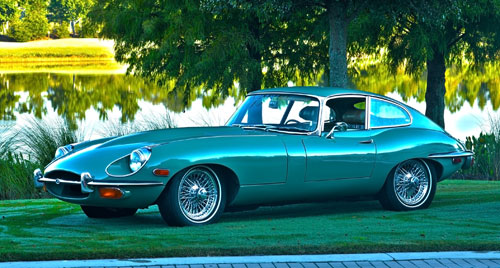Sophomore Slumps: The Series 2 Jaguar E-Type

This one defines the automotive sophomore slump. Following the home run ’61-’68 Series 1 Jaguar E-Type, the ’69-’71 Series 2 was a complete whiff, and a cautionary tale for other manufacturers about how not to mess with a successful formula.
In essence, for every decision the company made right with the first generation car, they made wrong with its successor. Every subtle styling touch was tampered with and spoiled, and the resulting car lost almost all the delicacy and poise of the original car’s design. Rather than hone and refine the Series 1 E-Type’s look, Jaguar actually went backward, cluttering the shape with ham-fisted, amateurish features.

There were engineering justifications for many of the decisions. The switch from the earlier car’s beautifully-shaped mouth with a simple bisecting chrome bar to the second-generation’s gaping maw was driven by greater cooling needs. And the wart-like turn signal clusters that appeared on the Series 2’s jowls were probably added to improve lighting visibility. The giant chrome box that took up residence under the newly-connected rear bumper bar was probably unnecessary, though, and its visual weight and angularity clashed with the rest of the car’s sinuous curves. The simple headlight covers disappeared as well, replaced by exposed lights caked with far too much chrome icing.

Even the engine suffered a styling downgrade. The polished, exposed cam covers gave way to ribbed, matte aluminum pieces surmounted by the carb warming duct. Even when it’s clean, the engine just looks dirty compared to the Series 1’s work of automotive art.
I’ve focused on the styling, but the detuning of the mechanicals also deserves mention. For as much drivability the styling changes added (better cooling, lighting, etc), the dual emissions-strangled Stromberg carburetors took away with vapor lock problems, airflow restrictions, etc. Performance decreased notably compared to the Series 1 E-Type, and reinforced the notion that the Series 2 was actually a step backward from its predecessor.
In fairness, the impetus for many of the changes didn’t arise from the automaker itself, but from the external pressure of US emissions and safety regulations, an important consideration for Jaguar’s biggest export market. That said, I would have hoped the Coventry firm would have dug a little deeper and found a way to accommodate the regulations while still integrating the needed changes more harmoniously with the E-Type’s shape and purpose. The car has eye-popping curb appeal and excellent performance; don’t uglify and neuter the primary reasons 99% of buyers purchase the car. I understand the regulations came out of left field for many automakers and caught many unprepared, but Jaguar wasn’t yet in dire financial straits in the late ’60s; they had the resources to, well, try a little harder. How I wish they would have.
Editor’s note: This post is part of an ongoing series highlighting cars whose second generation failed to live up to the promise of the first. Read the other installments here:

I would agree, the E-Type was taken down a notch or three as you so well described. The discussion prompted me to search the follow up, and to my eye it’s amazing, with several of the issues addressed. Here’s a ’74 Series 3: http://www.themotoringenthusiast.com/cars/74-e-type
A rhetorical thought occurs to me…how many timeless automobiles were produced in the decade between ’65 and ’75?
Most E-Type buffs would say rather than rectifying the Series 2’s flaws, Jaguar doubled down on them for the Series 3. :) The tacky wheel flares, the eggcrate grille filling the mouth, the ugly square bumper overriders… At least the Series 3, with the V12, had enough power to get out of its own way.
That’s a nice example you linked to as well. The coupe version of the Series 3 is beyond hideous; the roadster’s the only one I’d consider. And the engine bay pic of the one you linked to is a huge improvement over the quad-Stromberg factory arrangement:
http://www.flickr.com/photos/11248169@N00/2702402929/
I mean, when it stops looking like an engine, of all things, maybe you’ve gone too far, you know? :)
That one looks like a furnace boiler!